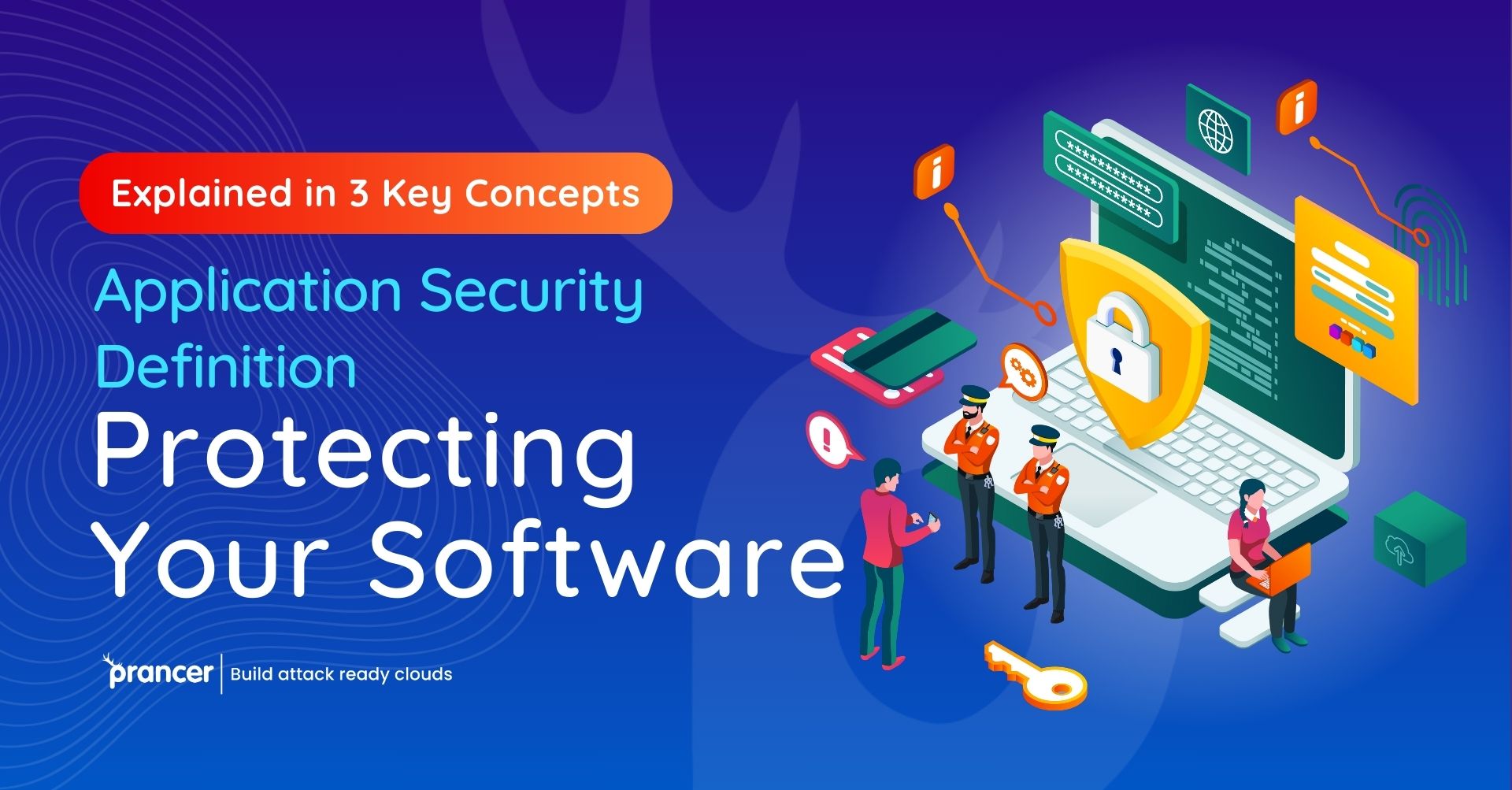

In the vast expanse of cybersecurity, getting to grips with the essence of Application Security is fundamental in fortifying your software against malicious onslaughts and unforeseen vulnerabilities. This domain accentuates the importance of securing your applications right from their architectural blueprint, to their design, implementation, testing, and upkeep. The prime goal is to defend your software, a vital asset, against a myriad of threats, ensuring its integrity, availability, and confidentiality remain unscathed.
In the vast and complex realm of cybersecurity, comprehension, and realization of an Application Security bring about a necessity to protect software from malevolent attacks as well as unexpected vulnerabilities. This perspective of cybersecurity implies that applications have to be secured from the very start of architectural planning, design, development process, and all maintenance operations. Using automated penetration testing is essential to this end since it detects and resolves possible threats proactively. This protects your software from numerous cyber threats and bears integrity, availability as well and confidentiality.
The phrase “Application Security Definition” envelopes the actions and measures adopted to reinforce the software against antagonistic maneuvers and threats. In a digital ecosystem where malicious attacks are relentless, embedding robust application security measures isn’t a choice but a critical imperative. Prancer, standing at the forefront in the cybersecurity arena, staunchly highlights the importance of robust application security measures. Through this piece, we venture into three pivotal concepts that serve as the cornerstone for shielding your software, steering towards a secure coding ethos.
The journey towards resilient software kicks off with the adoption of secure coding practices. This entails employing coding standards and guidelines to ward off common vulnerabilities such as SQL injection, Cross-Site Scripting (XSS), and Cross-Site Request Forgery (CSRF). Prancer, with its cutting-edge tools and expertise, aids organizations in nurturing a culture of secure coding, substantially mitigating the risks tied to malicious onslaughts.
Automated Penetration Testing emerges as a cardinal element of the Application Security Definition, empowering organizations to spot vulnerabilities in a system before malevolent forces take advantage. By mimicking adversarial attacks, it sheds light on the system’s fortitude and frailties, enabling the timely and efficient remediation of vulnerabilities. Prancer’s bespoke automated penetration testing services are crafted to align with the unique security needs of every organization, ensuring a fortified security stance.
In a cybersecurity landscape that’s ever-changing, the continuous monitoring and updating of security protocols is indispensable. Adopting a proactive stance in identifying and neutralizing potential threats is crucial. Prancer’s advanced monitoring solutions deliver real-time insights into your applications’ security status, ensuring they remain robust against the shifting threat landscape.
Prancer’s mission is intricately interwoven with the ethos of the Application Security Definition, tirelessly endeavoring to amplify the security frameworks of organizations. By offering state-of-the-art tools and services, Prancer not only aids in pinpointing and alleviating risks but also in cultivating a culture of security cognizance and resilience.
Nowadays, Application Security is needed to protect software from known and unknown threats in cyber space. This practice sheds light on the idea that application security begins at design and goes all way up to maintenance. Key strategies include:
Secure Coding Practices: Setting strong secure coding best practices to prevent vulnerabilities like SQL injections and XSS, with Prancer assisting organisations carry out these processes effectively.
Automated Penetration Testing: Prancer provides bespoke automated penetration testing to enhance security.
Continuous Monitoring and Updating: The field of cyber threats is a dynamic one, ergo constant monitoring and updating on security protocols. Prancer’s tools offer continuous knowledge to re-fresh against developing security risks.
Prancer contributed to the field of Application Security as a new source for hard-to-find tools helped companies uncover risk, strengthen security mechanisms and established an environment where cybersecurity is concerned everyday.
The Application Security skills are essential in the modern cybersecurity world because they protect software from various threats. This essential aspect of cyber security is the protection from applications that begin at ground zero-from design to development, implementation and sustaining operations. One of the driving forces that support this approach is automated penetration testing, which allows for proactive detection and resolution to potential vulnerabilities. The concentration on integrity, availability and confidentiality in application security gives a holistic coverage of the software assets.
Advanced Strategies in Application Security
Evolution of Secure Coding Practices: Strong code is the basis of efficient application security. This includes stringent code standards and rules to eliminate common vulnerabilities such as SQL injection, XSS or CSRF. Prancer’s tools and features enable organizations to embed a culture of secure coding that significantly reduces the likelihood of security attacks.
Strategic Automated Penetration Testing: This part of the application security allows organizations to identify vulnerabilities before they are exploited.
In automated penetration testing, both strengths and weaknesses of systems are identified as it mimics cyber attacks that allow for fast rectification. Prancer offers customized automated penetration testing services that address specific security needs and offer robust defense mechanisms.
Diligent Continuous Monitoring and Updating: The development of cyber threats is continuous; therefore, monitoring and timely updating are necessary. Security begins with early identification and control of threats. Whereas Prancer’s solutions provide real-time monitoring, they block applications from new threats.
Prancer’s Contribution to Application Security
Its products show that the commitment of Prancer to app security enhancement is evident. These advanced tools and services enable Prancer not only to identify the risks as well as risk mitigation but also form a security culture mindset in organizations. Their innovative approaches allow companies to manage current and potential cyber threats.
In the modern digital age, Application Security is a comprehensive strategy for protecting software against various cyber threats. It extends from the design level to maintenance, secure coding practices, automated penetration tests and continuous monitoring and update. In this region, the innovative tools and solutions offered by Prancer are crucial as they enable businesses to detect risks identifying deficiencies in security postures while building a proactive cybersecurity environment.
In the dynamic cybersecurity landscape, Application Security has always been key to preventing a variety of threats. This important aspect of cybersecurity addresses the need to protect applications from design, development through implementation and maintenance. Automated penetration testing is one of the most important elements in this process, which serves a significant role in proactive vulnerability detection and resolution to maintain software assets integrity; availability confidentiality.
Key Strategies in Application Security
Secure Coding Practices: Strong application security is based on such a code. To prevent weaknesses such as SQL injection, XSS and CSRF it is essential to follow strictly high coding standards and guidelines. In this regard, the provision of tools and skills from providers such as Prancer play a vital role in helping organizations develop secure coding culture that reduces chances of security breaches.
Automated Penetration Testing: This critical component of application security allows companies to detect vulnerabilities before exploitation. It demonstrates the strengths and weaknesses of a system through imitating cyberattacks, enabling timely and effective remediation. Personalized services provided by Prancer address specific security needs, forming a strong defense.
Continuous Monitoring and Updating: However, because cyber threats are dynamic the constant monitoring and regular updating of security measures is necessary. Such a proactive approach is critical for security, and services like Prancer offer real-time monitoring to ensure that applications are protected from changing threats.
Prancer’s Impact on Application Security
Prancer’s commitment to enhancing application security is manifested in the variety of innovative tools and services that it provides. Prancer supports the development of risk identification and mitigation culture within organizations. Their solutions are aimed at addressing current and future cybersecurity problems.
Comprehensive Application Security Approach
Secure Coding principles, strategic automated penetration testing and ongoing monitoring with updates are the basis of Modern Application Security which is a holistic approach to software development. In this respect, Prancer’s innovative tools and services are also important as they enable companies to identify weaknesses in their security positions ,improve them, and develop an active cybersecurity culture. This overall approach is needed to protect software against various cyber threats, ensuring the safety of digital assets in terms of their integrity, availability and confidentiality within a dynamic cyberspace.
Conclusion:
Grasping and implementing the core concepts enveloped in the Application Security Definition is vital for shielding your software assets. By nurturing secure coding practices, harnessing automated penetration testing, and ensuring continuous monitoring and updates, you can significantly amp up the security posture of your applications. Prancer, with its plethora of sophisticated solutions, stands as a guiding light and staunch ally in navigating the complex maze of application security.
